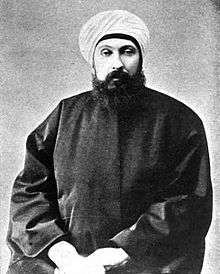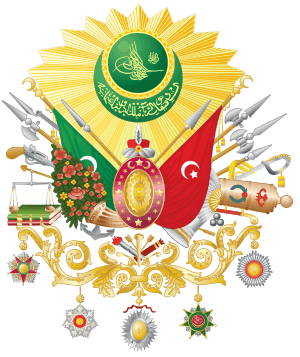Shaykh al-Islām
Shaykh al-Islām (Arabic: شيخ الإسلام, romanized: Šayḫ al-Islām; Ottoman Turkish: شیخ الاسلام, romanized: Şhaykḫu-l-İslām or Sheiklı ul-Islam[1]) was used in the classical era as an honorific title for outstanding scholars of the Islamic sciences.[2]:399[3] It first emerged in Khurasan towards the end of the 4th Islamic century.[2]:399 In the central and western lands of Islam, it was an informal title given to jurists whose fatwas were particularly influential, while in the east it came to be conferred by rulers to ulama who played various official roles but were not generally muftis. Sometimes, as in the case of Ibn Taymiyya, the use of the title was subject to controversy. In the Ottoman Empire, starting from the early modern era, the title came to designate the chief mufti, who oversaw a hierarchy of state-appointed ulama. The Ottoman Sheikh al-Islam (French spelling: cheikh-ul-islam[note 1]) performed a number of functions, including advising the sultan on religious matters, legitimizing government policies, and appointing judges.[2]:400[5]
With the abolition of the Caliphate in 1924, the official Ottoman office of Shaykh al-Islām, already in decline, was eliminated.[6] Modern times have seen the role of chief mufti carried out by grand muftis appointed or elected in a variety of ways.[3]
Classical usage
Like other honorific titles starting with the word sheikh, the term shaykh al-islam was in the classical era reserved for ulama and mystics. It first appeared in Khurasan in the 10th century (4th century AH).[2]:399 In major cities of Khurasan it seems to have had more specific connotations, since only one person held the title at a given time and place. Holders of the title in Khurasan were among the most influential ulama, but there is no evidence that they delivered fatwas. Under the Ilkhans, the Delhi Sultanate and the Timurids the title was conferred, often by the ruler, to high-ranking ulama who performed various functions but were not generally muftis.[2]:400
In Syria and Egypt the title was given to influential jurists and had an honorific rather than official role. By 700/1300 in central and western lands of Islam the term became associated with giving of fatwas. Ibn Taymiyya was given the title by his supporters but his adversaries contested this use.[2]:400 For example, the Hanafi scholar 'Ala' al-Din al-Bukhari issued a fatwa stating that anyone who called Ibn Taymiyya "Shaykh al-islam" had committed disbelief (kufr).[7][8] There is disagreement on whether the title was honorific or designated a local mufti in Seljuq and early Ottoman Anatolia.[2]:400
The following Islamic scholars have been given the title "shaykh al-islam":
- Ahmad Ibn Hanbal (b. 164 AH)
- Ibn Surayj[9][10] (b. 249 AH)
- Al-Daraqutni[9] (b. 306 AH)
- Ibrahim Niasse (b. 165 AH)
- Abu Mansur al-Maturidi[11] (b. 231 AH)
- Abu Hamid al-Isfarayini[9] (b. 344 AH)
- Al-Bayhaqi[9] (b. 384 AH)
- Abu Ishaq al-Shirazi[9] (b. 393 AH)
- Abu Talib al-Makki[12] (b. 386 AH)
- Khwaja Abdullah Ansari[2]:400 (b. 481 AH)
- Al-Juwayni[13] (b. 419 AH)
- Fakhr al-Din al-Razi[14] (b. 544 AH)
- Ibn al-Jawzi[9] (b. 509/510 AH)
- Al-'Izz ibn 'Abd al-Salam[15][16] (b. 577 AH)
- Ibn Daqiq al-'Id[17] (b. 625 AH)
- Al-Nawawi[18] (b. 631 AH)
- Ibn Taymiyyah (b. 661 AH)
- Taqi al-Din al-Subki[19](b. 683 AH)
- Taj al-Din al-Subki[20] (b. 727 AH)
- Ibn Hajar al-Asqalani[21] (b. 773 AH)
- Zakariyya al-Ansari[22][23][24][25] (b. 823 AH)
- Ibn Hajar al-Haytami[26] (b. 909 AH)
- Siraj al-Din al-Bulqini[27][28] (b. 724 AH)
- Ahmad Zayni Dahlan[29] (b. 1231 or 1232 AH)
- Ahmed Raza Khan Barelvi (1272 AH–1370 AH)
- Muhammad Tahir-ul-Qadri[30] (b. 1370 AH)
- Majd al-Din Ishāq[31]
Pre Modern Era
- Madni Miyan (b. 1357 AH)[32]
In the Ottoman Empire

In the Ottoman Empire, which controlled much of the Sunni Islamic world from the 14th to the 20th centuries, the Grand Mufti was given the title Sheikh ul-islam (Ottoman Turkish: Şeyḫülislām). The Ottomans had a strict hierarchy of ulama, with the Sheikh ul-Islam holding the highest rank. A Sheikh ul-Islam was chosen by a royal warrant amongst the qadis of important cities. The Sheikh ul-Islam had the power to confirm new sultans; but once the sultan was affirmed, the sultan retained a higher authority than the Sheik ul-Islam. The Sheikh ul-Islam issued fatwas, which were written interpretations of the Quran that had authority over the community. The Sheikh ul-Islam represented the law of shariah and in the 16th century its importance rose which led to increased power. Sultan Murad IV appointed a Sufi, Yahya, as his Sheikh ul-Islam during this time which led to violent disapproval. The objection to this appointment made obvious the amount of power the Sheikh ul-Islam had, since people were afraid he would alter the traditions and norms they were living under by issuing new fatwas.
The office of Sheikh ul-islam was abolished in 1924, at the same time as the Ottoman Caliphate. After the National Assembly of Turkey was established in 1920, the office of Sheikh ul-Islam was placed in the Shar’iyya wa Awqaf Ministry. In 1924, the office of Sheikh ul-Islam was abolished at the same time as the Ottoman Caliphate. The office was replaced by the Presidency of Religious Affairs. As the successor entity to the office of the Sheikh ul-Islam, the Presidency of Religious Affairs is the most authoritative entity in Turkey in relation to Sunni Islam.
References
- Hogarth, D. G. (January 1906). "Reviewed Work: Corps de Droit Ottoman by George Young". The English Historical Review. Oxford University Press. 21 (81): 186–189. JSTOR 549456. - CITED: p. 189: "'Sheikh-ul-Islam,' for instance, should be written 'Sheiklı ul-Islam,' and so forth. This mistake is common, but none the less a mistake." - Review of Corps de Droit Ottoman
- J.H. Kramers-[R.W. Bulliet] & R.C. Repp (1997). "Skaykh al-Islam". In Bosworth, C. E.; van Donzel, E.; Heinrichs, W. P. & Lecomte, G. (eds.). The Encyclopaedia of Islam, New Edition, Volume IX: San–Sze. Leiden: E. J. Brill. ISBN 90-04-10422-4.
- Gerhard Böwering, Patricia Crone, Mahan Mirza, The Princeton Encyclopedia of Islamic Political Thought, p 509-510. ISBN 0691134847
- Strauss, Johann (2010). "A Constitution for a Multilingual Empire: Translations of the Kanun-ı Esasi and Other Official Texts into Minority Languages". In Herzog, Christoph; Malek Sharif (eds.). The First Ottoman Experiment in Democracy. Wurzburg. p. 21–51. (info page on book at Martin Luther University) - Cited: p. 40 (PDF p. 42)
- James Broucek (2013). "Mufti/Grand mufti". In Gerhard Böwering, Patricia Crone (ed.). The Princeton Encyclopedia of Islamic Political Thought. Princeton University Press.
- Brockett, Adrian Alan, Studies in two transmissions of the Qur'an
- Correct Islamic Doctrine/Islamic Doctrine by Ibn Khafif
- The Biographies Of The Elite Lives Of The Scholars, Imams & Hadith Masters by Gibril Fouad Haddad
- Al-Dhahabi, Siyar a'lam al-nubala' ('Biographies of Noble Personalities').
- Constructive Critics, Hadith Literature, and the Articulation of Sunni Islam by Scott C. Lucas - Page 87.
- Gibril Fouad Haddad (2015). The Biographies of the Elite Lives of the Scholars, Imams and Hadith Masters. Zulfiqar Ayub. p. 141.
- Yazaki, Saeko (2012). Islamic Mysticism and Abu Talib Al-Makki: The Role of the Heart. Routledge. p. 122. ISBN 978-0415671101.
- M. M. Sharif, A History of Muslim Philosophy, 1.242. ISBN 9694073405
- Islam and Other Religions: Pathways to Dialogue by Irfan Omar
- Jackson, Sherman (1996). Islamic Law and the State: The Constitutional Jurisprudence of Shihab Al-Din Al-Qarafi (Studies in Islamic Law & Society). Brill. p. 10. ISBN 9004104585.
- Allah's Names and Attributes (Islamic Doctrines & Beliefs) by Imam Al-Bayhaqi (Author), Gibril Fouad Haddad (Translator)
- Islamic Culture - Volume 45 - Page 195
- Correct Islamic Doctrine/Islamic Doctrine - Page 11.
- Mohammad Hassan Khalil, Islam and the Fate of Others: The Salvation Question, Oxford University Press, 3 May 2012, p 89. ISBN 0199796661
- Tasawwuf al-Subki
- Gibb, H. A. R.; Kramers, J. H.; Lévi-Provençal, E.; Schacht, J.; Lewis, B. & Pellat, Ch., eds. (1960). The Encyclopaedia of Islam, New Edition, Volume I: A–B. Leiden: E. J. Brill. p. 791. OCLC 495469456.
- Bearman, P. J.; Bianquis, Th.; Bosworth, C. E.; van Donzel, E. & Heinrichs, W. P., eds. (2002). The Encyclopaedia of Islam, New Edition, Volume XI: W–Z. Leiden: E. J. Brill. p. 406. ISBN 90-04-12756-9.
- Safinah Safinat al-Naja' - The Ship of Salvation
- Timbuktu and the Songhay Empire by John O. Hunwick
- The Archetypal Sunni Scholar: Law, Theology, and Mysticism in the Synthesis of Al-Bajuri by Aaron Spevack
- The Prophets in Barzakh/The Hadith of Isra' and Mi'raj/The Immense Merrits of Al-Sham/The Vision of Allah by Al-Sayyid Muhammad Ibn 'Alawi
- [Mamluk Studies Review - Volume 6 - Page 118.]
- The Biographies Of The Elite Lives Of The Scholars, Imams & Hadith Masters by Gibril Fouad Haddad.
- Muhammad Hisham Kabbani (2004). The Naqshbandi Sufi Tradition Guidebook of Daily Practices and Devotions. Islamic Supreme Council of America. p. 187. ISBN 9781930409224.
- International, Minhaj-ul-Quran. "A Profile of Shaykh-ul-Islam Dr Muhammad Tahir-ul-Qadri - Minhaj-ul-Quran". www.minhaj.org. Retrieved 2019-10-24.
- Richard Todd The Sufi Doctrine of Man: Ṣadr al-Dīn al-Qūnawī's Metaphysical Anthropology BRILL, 28.05.2014 ISBN 9789004271265 p. 13
- "Eminent scholar starts religious discourses". thehansindia.com.
External links
| Wikisource has original text related to this article: |
